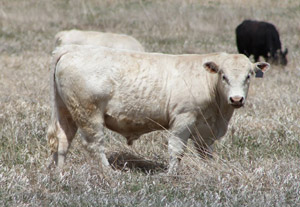A Quick Shot for Thought: Take Aim at Controlling Breeding Costs
June 2015

With cattle markets at record high prices cow-calf producers find themselves competing for production inputs at higher costs. In an effort to economize, questions that may arise might be “What is a breeding bull worth?” or “How much per calf are my breeding costs?”.
The following four factors could potentially alter breeding costs.
- Bull prices,
- Calving rate,
- Cow to bull ratio, and
- Cull bull price.
The costs were analyzed using the “Cow/Heifer Breeding Cost Cow-Q-Lator” Excel spreadsheet tool (link to spreadsheet provided below). There are various other factors which we leave for discussion at another time.
Using representative base values, we estimate that the average breeding costs are $110.26 per weaned calf. This is based on an average calving rate of 87% (the percent cows weaning a calf after being exposed to a bull). Cull bulls averaged 2,000 pounds, with a 4-year useful life, a mortality rate of 2%, and a salvage value of $120.00 per cwt. The expected interest rate was 6% on investment. The ratio of cows per bull was 25:1. Bulls were purchased at a value of $6,000, with annual depreciation and costs of maintenance of $2,218 (e.g., feed, labor, vet, etc.).
Bull prices
It was found that for every dollar of bull value about $0.014 (just less than one and half cents) of breeding costs (defined here as cost per weaned calf) were incurred. A bull purchased for $7,000 costs $14.12 more per calf produced versus a $6,000 bull. In the case of the base scenario, breeding costs would go from an estimated $102.05 to $116.17 per weaned calf. To make purchasing the $7,000 bull viable it must have an average return of at least $14.12 per weaned calf, any less and the bull buyer would be financially ahead by purchasing the $6,000 bull. This same method can be used to evaluate any bull purchase choice.
Calving rate
For each 1% change in calving rate, breeding costs inversely change by approximately $1.20 per weaned calf. While seemingly small, please note that breeding costs are only a portion of the true costs of calving rate changes (i.e., fewer calves to sell). The more significant costs are of feeding and maintaining an unproductive cow. This 1% change in calving rate for 100 cows amounts to an addition or subtraction of $1,425 revenue by either adding or subtracting the value of a weaned calf, assuming a 500-pound calf valued at $285/cwt.
Cows to bull ratio
For each additional cow above the 25 base cows serviced by a sire, costs decrease by approximately $4.68 per weaned calf. A reduction in the ratio of cows per bull increased costs by the same amount. For each 100 weaned calves, this amounts to a $468 cost savings or expenditure for each additional or subtracted cow. This becomes a significant costs savings if, for example, the ratio of cows to bulls were to increase by 5 cows, which leads to a $2,342 savings per 100 weaned calves. However, any increase in cow per bull should be carefully considered since any downside events may rapidly increase risk and could reduce calving rate.
Cull bull prices
Weaned-calf breeding costs are inversely tied to cull bull values by an estimated $0.22 for every $1.00 change in hundred weight (cwt) prices. A positive $10/cwt in the value of cull animals reduces breeding cost on average by approximately $2.20 per weaned calf.
Conclusion
These four factors are not the only variables to consider when thinking about controlling breeding costs. Other management choices might include deferring part of the costs by sharing bulls, or charging breeding fees. The point is that the more money paid for a bull the more revenue, or returns, are required to obtain the same level of profitability. Therefore, careful consideration of returns, which meet or exceed the added expense, should naturally be part of the bull purchase decision.
Increasing calving rate by various cost effective management choices is likely to have a larger impact on overall profits then on breeding costs.
The cow to bull ratio is an important variable to consider and has the potential to reduce costs significantly, but care must be taken in its implementation since a “wreck” could significantly reduce revenues and profits.
Bull salvage value helps mitigate bull costs. The higher the value of the bull at salvage the lower the breeding costs. Therefore, considering new or different ways of marketing, purchasing and rotating breeding bulls may be a worthwhile exercise.
For every decision there is a consequence. Those who are able to best understand the true consequences of their decisions are able to make better choices that lead to the outcomes they desire.
NOTE: The extended version of this paper and the downloadable Excel spreadsheet tool can be found on the UNL Farm and Ranch Management website. If you need any help downloading, or using this tool, please contact me at mstockton2@unl.edu or (308) 696-6713.
Matt Stockton
UNL Agricultural Economist